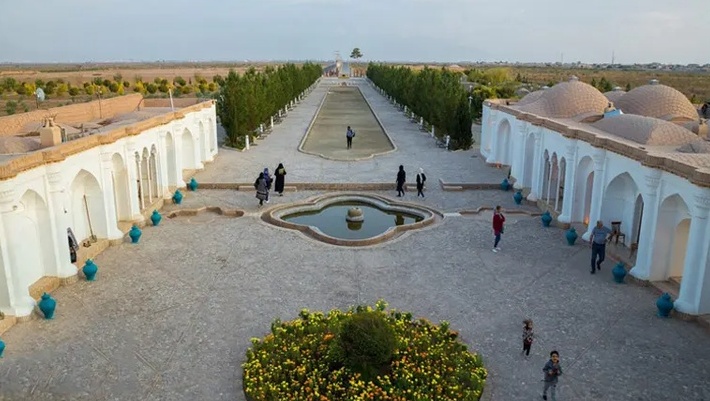SAEDNEWS: Fathabad Garden in Kerman, often called Iran’s Taj Mahal, dazzles visitors with its Persian architecture, lush greenery, and historic charm. A must-visit for anyone seeking beauty and history in one place.
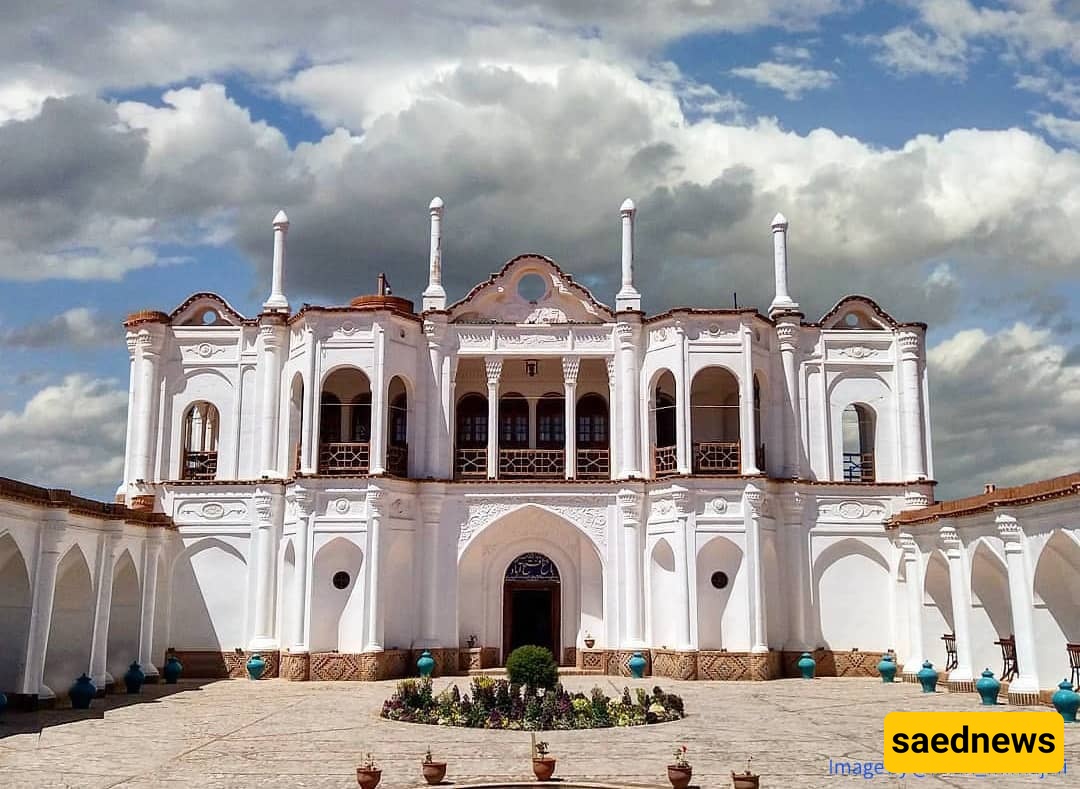
Bold, large, and written in Nastaliq script on its blue portal was “Fathabad Garden,” but they had forgotten to include the name of its Beglerbey. A gate that, to be admired, requires first passing by the rectangular pool of the garden. As soon as you step on the courtyard’s stone pavement, your gaze falls directly on the large white building, which for some reason does not have the same feel as the other historical buildings of Kerman province; I am referring to its architectural style and white plasterwork.
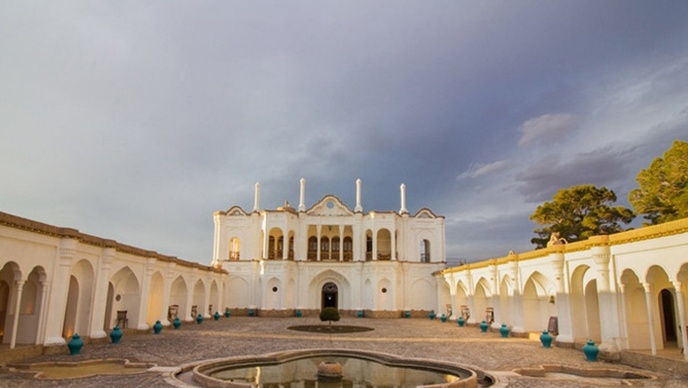
It seems that the qanats of Kerman do nothing but give life. There is the Mahan Prince Garden, whose life is indebted to the foothills of Tigran, and then there is Fathabad Garden, which considers itself part of the Rustamabad qanat. A qanat whose water was directed from a small channel by the street into the garden, not only watering its plants but also refreshing the visitors.
Its name was taken from Fazl Ali Khan Qara Baghi, known as Beglerbey, another ruler of Kerman. He began laying the foundations of Fathabad Garden in Kerman between 1216 and 1218 (according to the Iranian calendar). But it was the son of Hossein Ali Khan who continued the work during the reign of Mohammad Shah Qajar. It took five years to lay brick upon brick and complete it. Fazl Ali Khan himself only once a week indulged in visiting his Fathabad Garden.
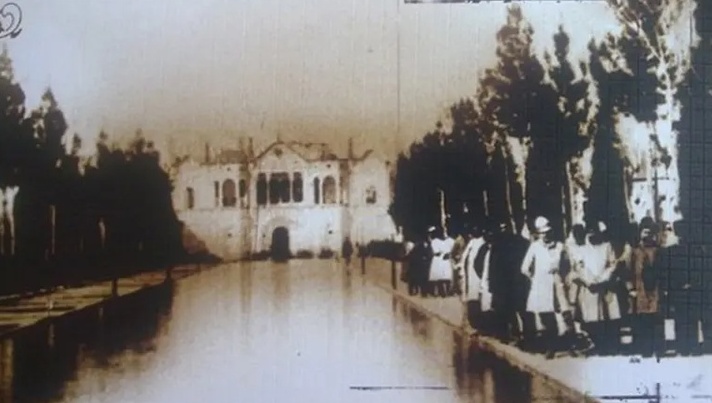
He was so eager to admire the garden that subsequent rulers of Kerman also wanted to possess the Beglerbey’s garden. Between us, even the Mahan Prince Garden was modeled after this garden – now whether that is true or not, let those who said it take the blame – but it seems they are not entirely wrong. From what I see, it appears that only the rulers of Kerman could build all the grand and luxurious gardens in order to come and enjoy aristocratic leisure.
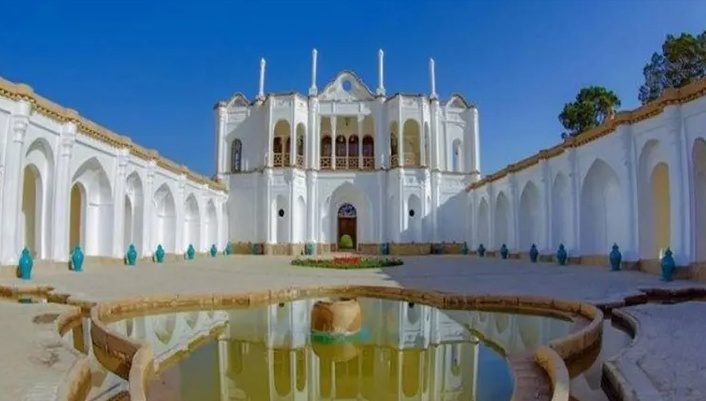
Fathabad Garden in Kerman was so magnificent and captivating that it held the gaze of all rulers. The story goes so far that one of the rulers of Kerman, Abdul Hossein Mirza, dared to offer to buy the garden from its owner, but was refused. I understand if one goes and builds a garden and then sells its pride.
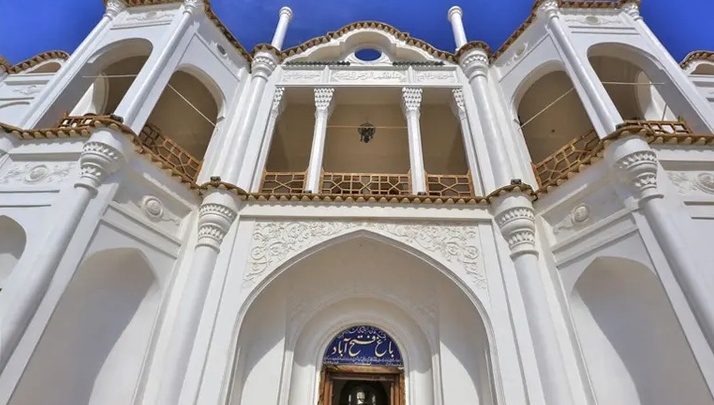
Although for years no one dared to sell Fathabad Garden to anyone, when it came to Rustam Khan Amiri, his family turned paradise into hell over the division of the garden. This led him to do what previous rulers would not do for money.
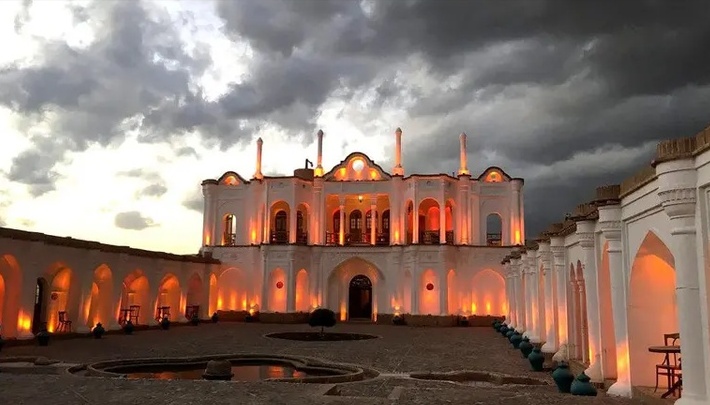
When Rustam Khan saw that his family had their eyes on every part of the garden, and that these disputes were making him bitter, he gave up on the garden and in 1352 (Iranian calendar) dedicated it as a waqf. With this act, he both returned to his earlier way of life and removed the responsibility of maintaining the garden from his shoulders.
Be alert to see how Fathabad Garden, with its five ancient trees, becomes a model for the Prince Mahan Garden, which is among the top nine Iranian gardens, while it itself barely makes it onto the list of national heritage sites and misses out on international recognition. This is how Beglerbey Garden loses its old charm. Yet it still becomes one of the most important water suppliers for the people of Kerman. When officials see that this garden’s heart is with the people, they step in to restore it before it is completely ruined.
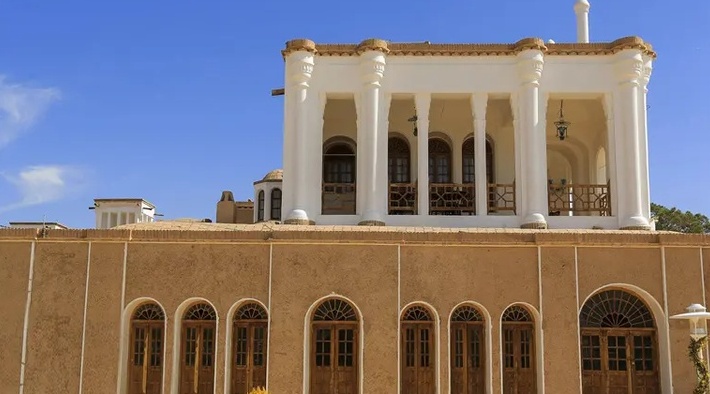
If you had visited Prince Mahan Garden before the restoration of Fathabad Garden, watching Beglerbey Garden would not have been enjoyable. For several decades, the state of its buildings and garden was poor and neglected. Not even a single person would give a few drops of water to its flowerpots.
But when Fathabad Garden in Kerman was registered as a national heritage site on 12 Bahman 1381 (Iranian calendar), it blossomed for the first time. Restoration of Beglerbey Garden began in 1393 and within a year, thanks to the efforts of skilled Iranian craftsmen, it gained new life. Now, “infinite galaxy” is the only phrase I can use to describe it.
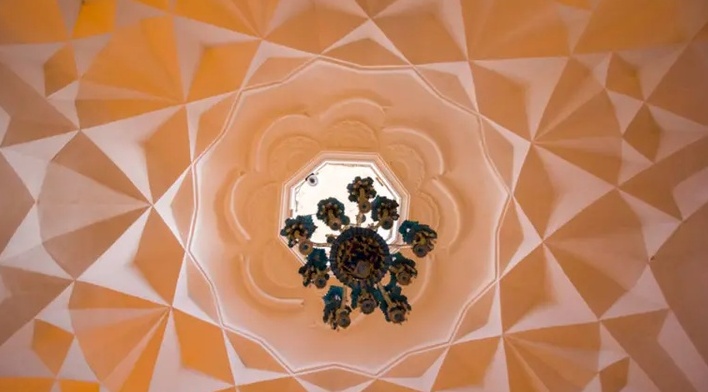
All Iranian gardens throughout the reigns of various kings shared certain characteristics and structures. However, the building and layout of Fathabad Garden differ from the classical structures of other Iranian gardens. This garden is among the few Iranian gardens with four slender minarets in front of its main building, which seems unusual among Kerman’s historical structures. Although the building’s walls were once made of brick and clay, today they are covered with plaster.
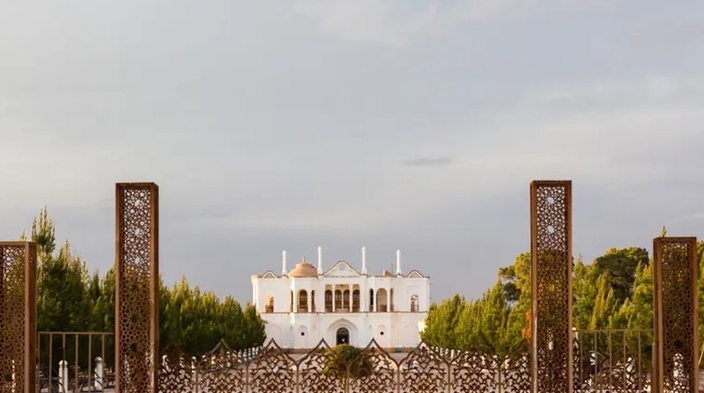
One of the wonders of Beglerbey Garden is the absence of a formal entrance gate. You cannot clearly tell where the garden ends and the outside begins. Only with iron columns can you roughly guess where you entered the courtyard and where you exit. The garden’s lighting, in addition to the beauty of the white building under the bright blue sky, becomes enchanting at night with colorful illumination. Although it is obvious that such lighting did not exist in the Qajar era, today it captivates many hearts. Its large size, 13 to 14 hectares with a 1,500-square-meter main building, is impressive beyond words.
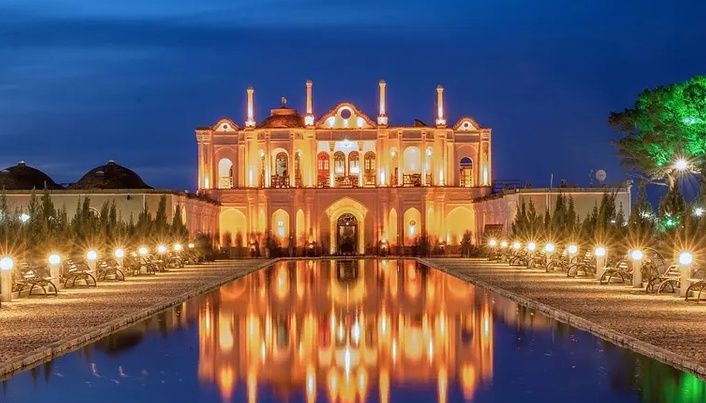
Beglerbey Garden consists of three main sections: the main avenue, the inner garden, and the second garden avenue. The main avenue features a large rectangular pool with cypress and pine trees on both sides. At the end of this avenue, to the left, you find the second section, the inner garden, which served as a private courtyard and the Four Seasons Mansion of the garden’s owner, lined with two rows of trees as a welcoming path.
In the third section, added during restoration, you can see the pistachio avenue or garden street. The Rustamabad qanat was so abundant that the elders were inspired to plant pistachio trees. Yet the main building, which connects all these sections, is the primary structure of Fathabad Garden.
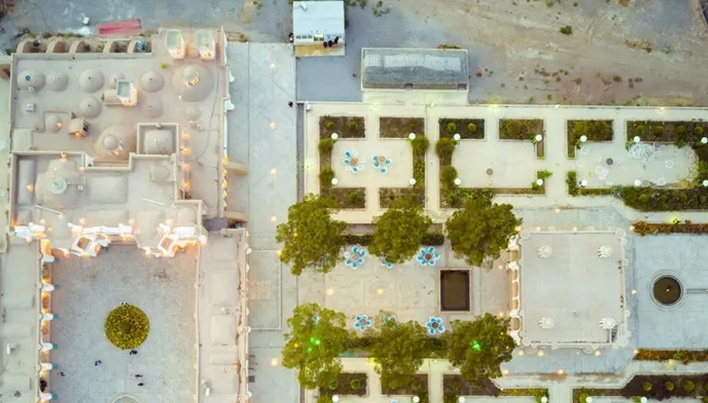
That large, two-story white building you see at the northern end of the garden is a masterpiece of Iranian-European architecture from the Qajar era. With its three- and five-door rooms, it has captured everyone’s admiration. Iron and steel beams could not display authentic Iranian architecture in Kerman, so only raw bricks and clay mortar with a plaster finish could reveal the infinite beauty of the pavilion or main building, with its arches, four minarets, and dome. This mansion is located at the core of the garden, drawing everyone’s attention, and it features magnificent lighting.

One of the curious sections of Fathabad is its museum of Kerman’s governors, where their portraits and biographies are preserved. But what remarkable deeds did they really accomplish to deserve a museum? Even this very garden of Fathabad was built for the pleasure and recreation of Kerman’s rulers, not for the people. Nevertheless, there were governors who worked tirelessly, thinking they were serving the people, staying up all night.
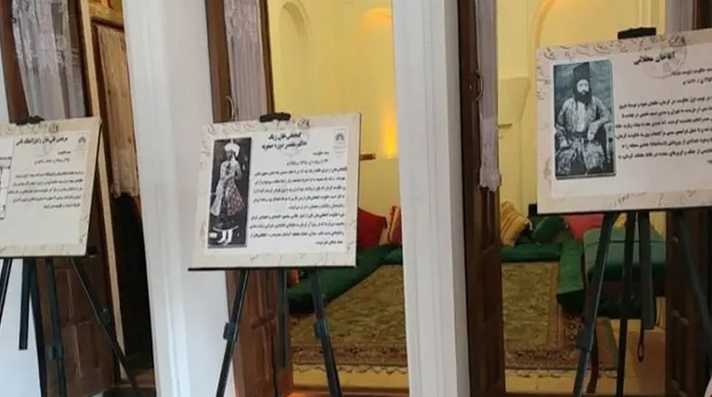
The white walls of Fathabad Garden are perfect for picking up a brush dipped in warm or cool colors and letting your creativity flow onto the walls. Of course, this could only happen in your imagination, because no one was allowed to do it. However, during the Qajar period, the rulers’ artists were permitted to enjoy painting miniatures or murals on the walls. They often painted using gold water.
This room was in the main mansion, where the rulers rested, but they could not tolerate the plain, empty walls. Therefore, they ordered murals and decorations to be added. Some of these murals have even been stolen, though it is unclear how one could steal an entire wall painting.
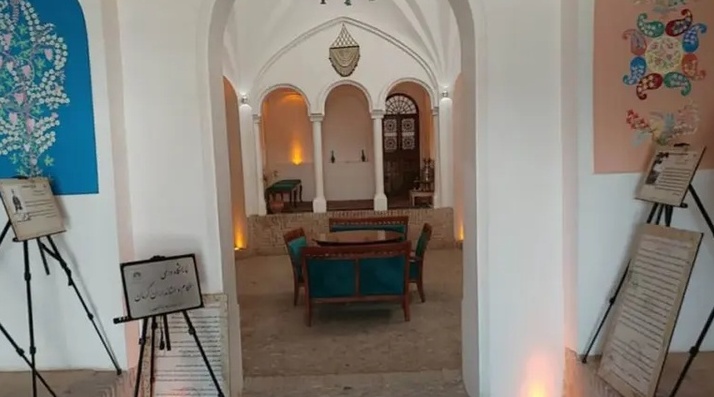
Again, there is a courtyard with a rectangular pool, which draws you inside under the pretext of washing your hands, and you never want to leave. Several large and small pools align along the courtyard, each more visually appealing than the last. The rectangular pool is 60 meters long and six meters wide, with circular flower-like pools at both ends. Alongside the courtyard are narrow-columned arcades, decorated with turquoise pots and brown chairs, creating a unique atmosphere for admirers of the garden.
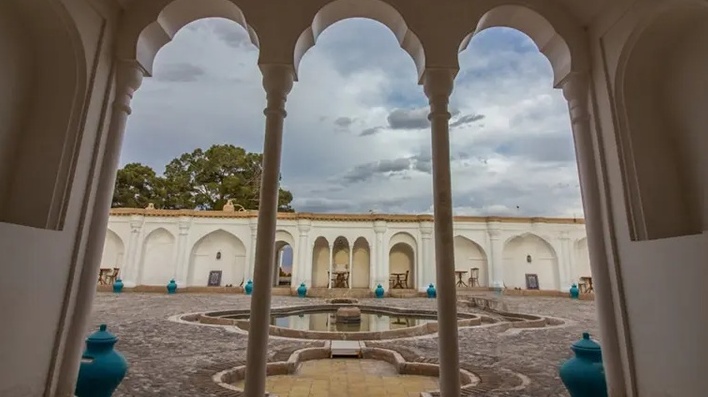
Even Prince Mahan Garden had a small private courtyard for the owner, let alone Beglerbey Garden, which has a personal mansion instead of a simple courtyard. And this is not just any mansion, but a small garden with a small mansion featuring a circular pool in the center.
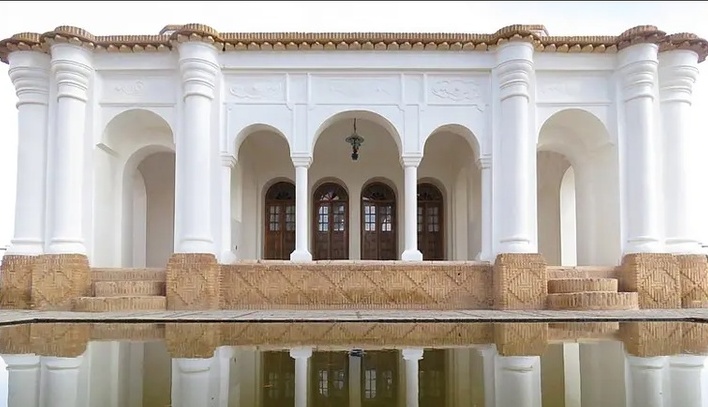
This mansion hides among the trees yet is outward-facing, with doors and windows opening to all directions. As soon as you enter Fathabad Garden, look to your right to see the Four Seasons Mansion with its front pool, whose architecture differs entirely from the main pavilion.
It is truly unique: a single-story mansion with arches, brick and plaster work, and white walls. Its wooden windows are fitted with glass, and an Iranian carpet covers the floor, leaving a stunning impression. Today, this luxurious room is prepared for various ceremonies and celebrations.
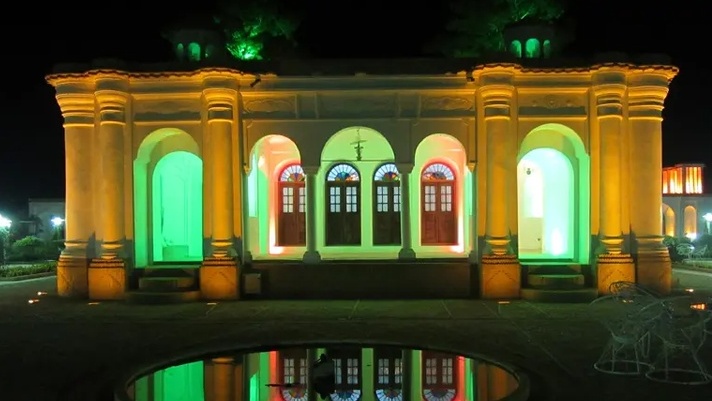
The garden also has a fruit orchard. Fourteen species of trees are cultivated across sixteen plots within the 3.7-hectare Fathabad Garden, ranging from olive, barberry, and pomegranate to peach, pear, yellow plum, mulberry, quince, apple, persimmon, nectarine, fig, and grape. Acacia, hawthorn, and saffron trees are among the garden’s non-fruiting trees.
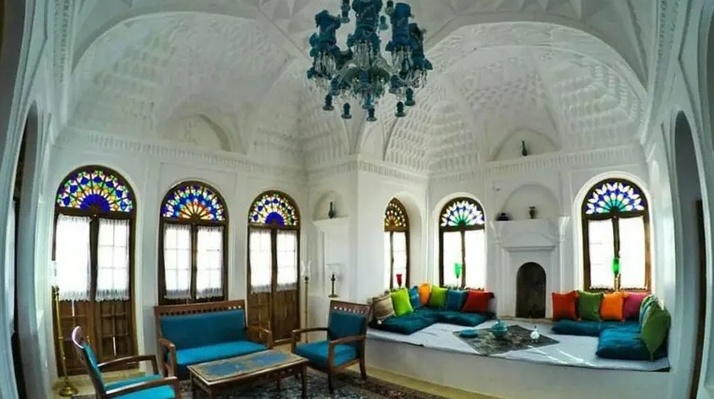
When authorities began restoring Fathabad Garden, a section was allocated for cultivating medicinal plants, so that in addition to producing botanical resources, it could also cover the garden’s expenses. Today, one of the largest medicinal plant cultivation complexes in the country relies solely on its wells and water purifiers for survival due to the drying of the Rostamabad qanat.
You can enjoy various types of kebabs and traditional Kerman dishes, from local soups and tandoor bread to stuffed vegetables, in a restaurant located inside the main mansion. In the open-air area, there is a beverage and tea house offering herbal drinks, infusions, aromatic medicinal plants, and ice cream to refresh visitors. Several seating areas are set up in the courtyard, along with wooden pavilions around the mansion, providing spaces to relax and breathe.
Fathabad Garden can be visited throughout the year, but the best time, especially in the hot climate of Kerman, is during spring and summer, when the plants are in full bloom.
The structure built decades ago by one of Kerman’s rulers has transformed into a garden that, with the blossoms of its trees, is hardly inferior to paradise. Even with its white building, luxurious four-season mansion, fruit orchard, pistachio trees, and lighting, it is more flourishing than during the Qajar era, captivating not the rulers but the hearts of passionate visitors. Perhaps it is Kerman’s scarcity of water that makes gardens like the Beglerbey Garden stand out so vividly. Witness how the people of Kerman create such paradises from arid land.
It feels as if I have seen this garden somewhere before; it constantly occupies my mind. I don’t know about you, but the vastness of its courtyard reminds me of Prince Mahan Garden, and the white main building with its minarets brings the architecture of India’s Taj Mahal to mind, even though the two have no relation.
